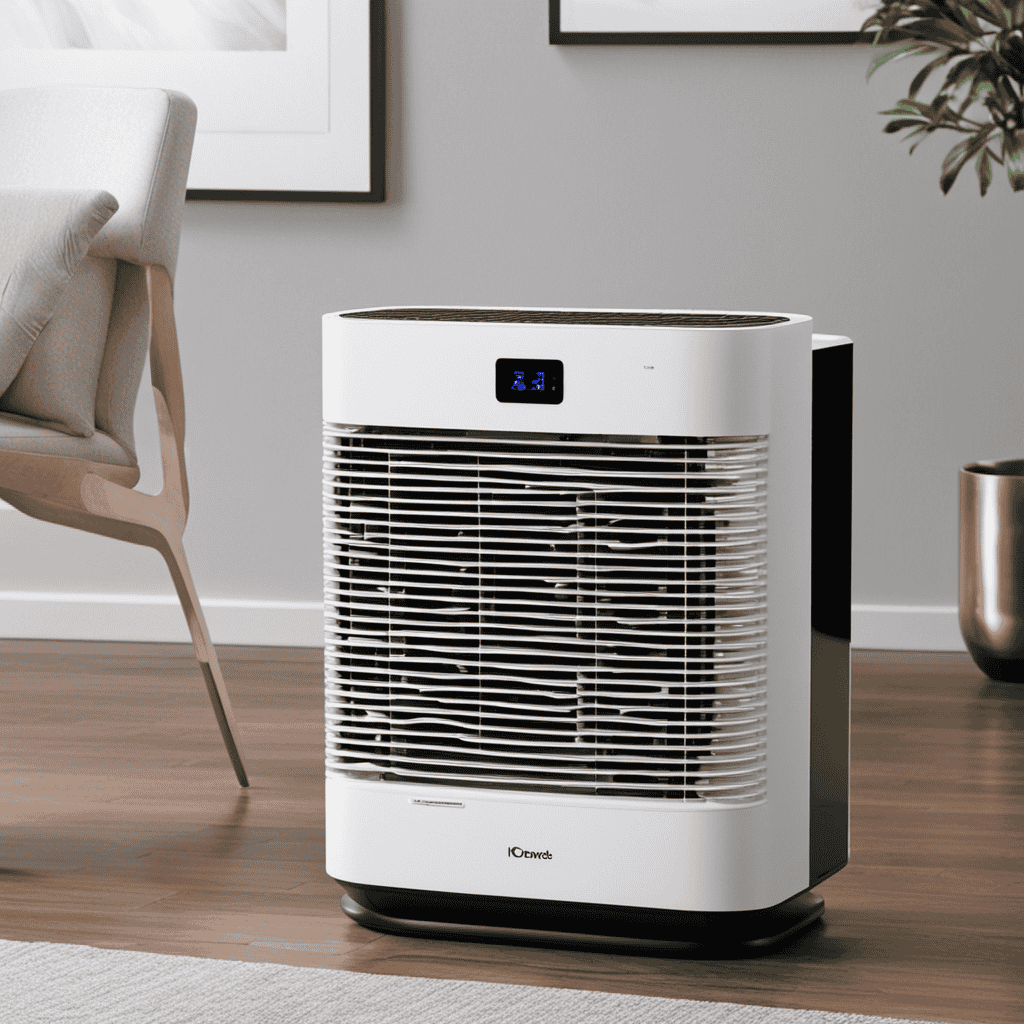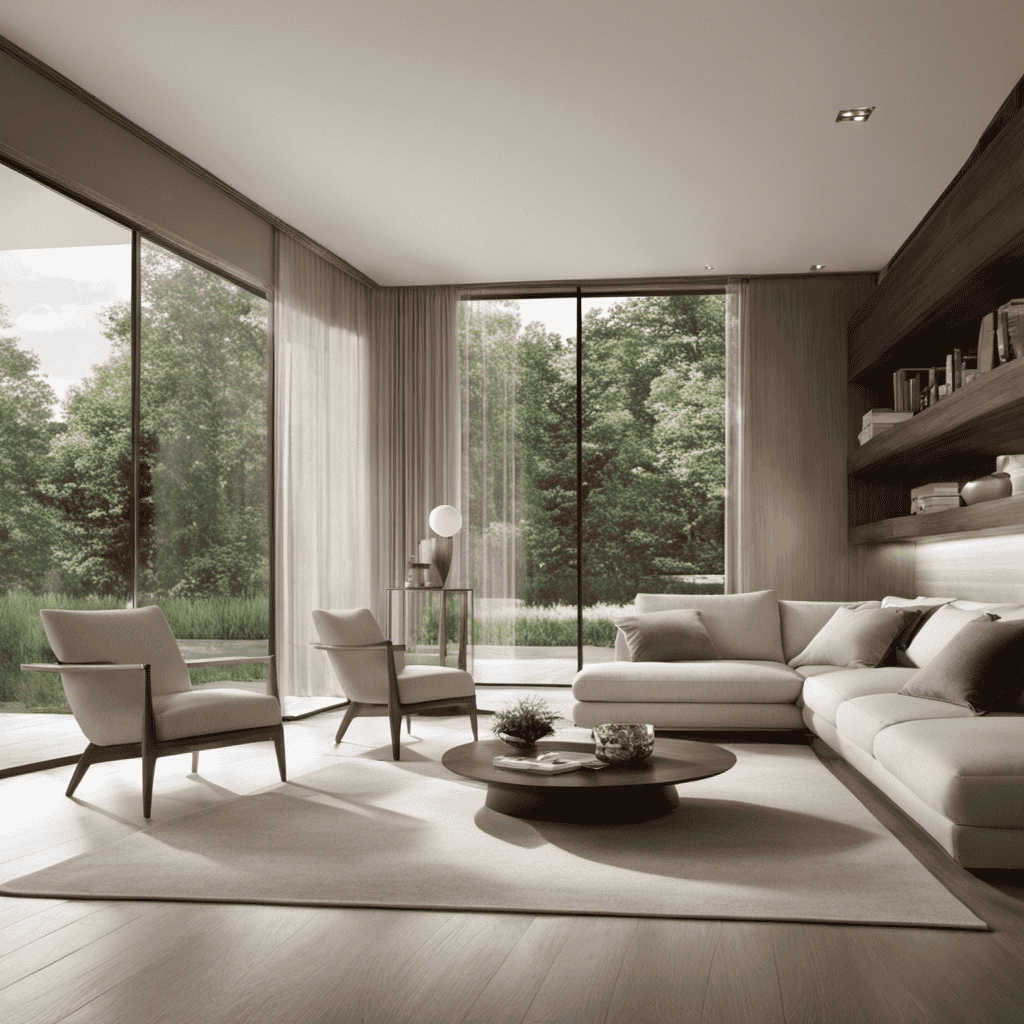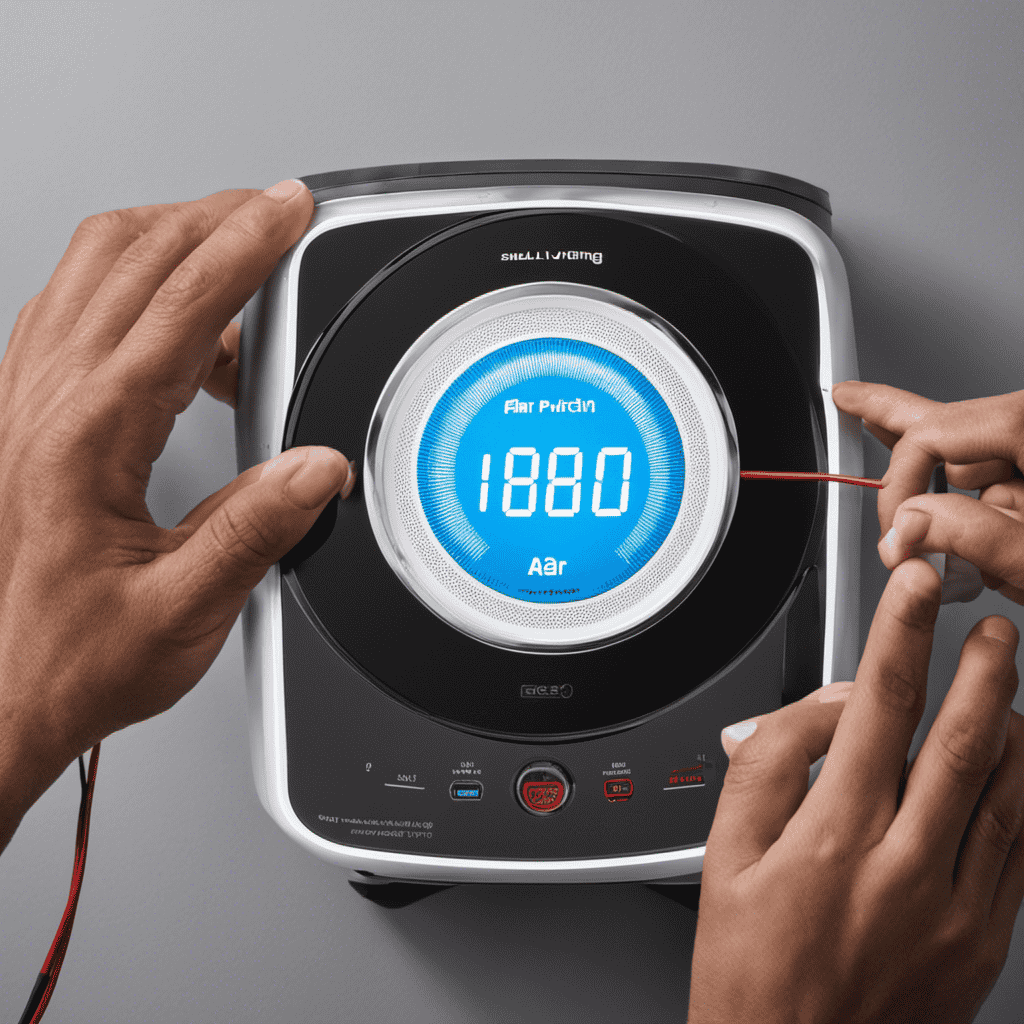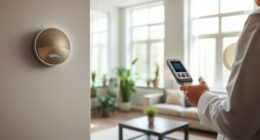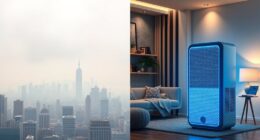Did you know that indoor air can be up to 5 times more polluted than outdoor air? Given this alarming statistic, it is crucial to prioritize effective air purification in our homes.
In this article, I will explore the factors that determine how many times an air purifier should turn over a room. From understanding the importance of air exchange to calculating the optimal turnover rate for different room sizes, we will delve into the technical aspects of achieving clean and healthy indoor air.
Key Takeaways
- The turnover efficiency of an air purifier is an important factor to consider when selecting one for a room.
- For small rooms, a compact design, high CADR rating, and low noise level are recommended.
- For large rooms, consider the coverage area, multiple filters, and a powerful fan.
- Understanding and optimizing air purifier fan speeds and airflow can help in maximizing performance and conserving energy.
Factors to Consider When Determining Air Purifier Turnover
When determining air purifier turnover, there are several factors to consider.
Room ventilation plays a crucial role in the effectiveness of an air purifier. The size of the room, the number of windows, and the presence of other ventilation systems can impact the air circulation.
Additionally, the level of air quality control required is an important consideration. If the room is prone to high levels of pollutants or allergens, a higher turnover rate may be necessary. On the other hand, for a room with lower pollution levels, a lower turnover rate may be sufficient.
It is important to assess the specific needs of the room and adjust the air purifier turnover accordingly to ensure optimal air quality and purification.
The Importance of Air Exchange in a Room
To ensure clean and fresh air in your space, it’s crucial to prioritize the exchange of air within the room. Proper ventilation plays a vital role in maintaining good indoor air quality. When air is exchanged regularly, it helps to remove pollutants, allergens, and odors from the room. This process is essential for creating a healthy and comfortable environment.
The benefits of air exchange in improving indoor air quality are numerous. It reduces the concentration of harmful substances, such as volatile organic compounds (VOCs), carbon dioxide, and dust particles. It also helps to control humidity levels, preventing the growth of mold and mildew. By ensuring proper air exchange, you can significantly enhance the overall air quality in your space.
Understanding air purifier CADR (Clean Air Delivery Rate) ratings is another important aspect of maintaining clean and fresh air, which we will explore in the subsequent section.
Understanding Air Purifier CADR Ratings
When it comes to choosing an air purifier, understanding CADR ratings is crucial.
One important factor to consider is the relationship between CADR and room size.
A higher CADR rating indicates that the air purifier can effectively clean a larger room, while a lower CADR rating may be more suitable for smaller spaces.
Additionally, comparing CADR ratings among different models can help determine which air purifier is the most effective in providing clean and purified air.
CADR and Room Size
You should consider the CADR rating and the size of your room when choosing an air purifier. The CADR, or Clean Air Delivery Rate, measures the effectiveness of an air purifier in removing pollutants from the air. It is typically expressed in cubic feet per minute (CFM). The higher the CADR rating, the faster the air purifier can clean the air in your room. The size of your room is also important because it determines the air purifier’s coverage area. A larger room will require an air purifier with a higher CADR rating to effectively clean the air. Additionally, you should consider the noise level of the air purifier, as well as the filter lifespan and maintenance requirements. Table below summarizes the key factors to consider when choosing an air purifier.
| Factor | Importance | Recommended Range |
|---|---|---|
| CADR rating | High | Varies based on room size |
| Room size | High | Varies based on CADR rating |
| Noise level | Medium | Less than 50 decibels |
| Filter lifespan and maintenance | Medium | Depends on usage and filter type |
Effective Air Purification
Consider the effectiveness of an air purifier by looking at factors such as the CADR rating, noise level, and filter lifespan. These factors play a crucial role in determining the quality of air purification.
The CADR rating, or Clean Air Delivery Rate, measures how efficiently the air purifier can remove pollen, dust, and smoke particles from the air. A higher CADR rating indicates a more effective air purifier.
Noise level is another factor to consider, especially if you plan to use the air purifier in your bedroom or office. A quieter unit ensures a peaceful environment while still providing clean air.
Lastly, filter lifespan determines how long the air purifier can effectively remove contaminants. Regularly replacing the filter ensures optimal air purification.
Comparing CADR Ratings
When considering the effectiveness of an air purifier, one of the important factors to consider is its Clean Air Delivery Rate (CADR) rating. CADR measures the volume of clean air that an air purifier can deliver in a specific period of time. It is expressed in cubic feet per minute (CFM).
The higher the CADR rating, the more efficient and faster the air purifier can clean the air in a room. To determine the number of times an air purifier should turn over a room, you need to consider the size of the room and the CADR rating of the purifier.
Divide the CADR rating by the room’s volume to calculate the purifier turnover rate. Ideally, the purifier should be able to complete a turnover every 15 to 30 minutes for optimal air quality.
Recommended Air Changes per Hour (ACH) for Different Spaces
The recommended ACH for different spaces varies depending on factors such as room size and occupancy. To determine the appropriate ACH for a specific area, it is crucial to consider the following factors:
-
Room size: The size of the room plays a significant role in determining the recommended ACH. Larger rooms typically require a higher ACH to ensure proper air filtration and circulation.
-
Occupancy: The number of occupants in a room also affects the recommended ACH. Spaces with a higher occupancy, such as conference rooms or classrooms, may require a higher ACH to maintain air quality.
-
Specific needs: Certain spaces, such as hospitals or laboratories, may have specific air quality requirements due to the presence of contaminants or sensitive equipment. In such cases, a higher ACH may be necessary to provide optimal air purification.
Higher ACH rates in a room offer several benefits, including improved indoor air quality, reduced exposure to pollutants, and enhanced overall health and well-being. Understanding the factors that affect recommended ACH can help determine the appropriate air purifier turnover for different spaces.
Now, let’s explore how room size affects air purifier turnover.
How Room Size Affects Air Purifier Turnover
When it comes to air purifiers, the size of the room plays a crucial role in determining the optimal performance.
Different room sizes require different levels of air turnover to effectively clean the air.
It is important to consider the purifier turnover efficiency, which refers to how quickly the purifier can filter the air in a given space, and match it with the appropriate room size for maximum effectiveness.
Optimal Room Size
To determine the optimal room size for an air purifier, you should consider the square footage of the space. Here are three key factors to consider:
-
Recommended Room Size: Every air purifier has a recommended room size that it can effectively purify. This information is usually provided by the manufacturer and is based on the air purifier’s capacity and performance. It is important to choose an air purifier that is suitable for the size of your room to ensure efficient and effective air purification.
-
Air Purifier Capacity: The capacity of an air purifier refers to the volume of air it can clean in a given time period. This information is usually measured in terms of air changes per hour (ACH). The higher the ACH, the more times the air purifier can turn over the room’s air, resulting in better air quality.
-
Room Layout and Airflow: The layout of your room and the airflow patterns within it can also affect the performance of an air purifier. It is important to consider factors such as the placement of furniture, doors, windows, and vents. These elements can impact the circulation of air and the overall effectiveness of the air purifier.
Purifier Turnover Efficiency
Consider maximizing the efficiency of your air purifier by ensuring that it cleans the room’s air multiple times.
The turnover efficiency of an air purifier refers to how effectively it can remove pollutants from the air within a given timeframe. Several factors can affect the turnover efficiency of an air purifier, including the size of the room, the airflow rate of the purifier, and the level of pollutants present.
To improve air purification effectiveness, it is important to choose an air purifier that is suitable for the size of the room and has a high airflow rate. Additionally, maintaining and replacing the filters regularly can also contribute to better turnover efficiency.
Recommendations for Small/Large Rooms?
For better performance in small or large spaces, it’s important to choose the right size air purifier. When it comes to recommendations for small rooms, here are three key factors to consider:
-
Compact Design: Look for air purifiers that are specifically designed for small spaces. These models are usually more compact in size, making them ideal for bedrooms, offices, or small apartments.
-
High CADR Rating: CADR, or Clean Air Delivery Rate, measures the effectiveness of an air purifier in removing pollutants. Opt for an air purifier with a higher CADR rating, as it indicates faster and more efficient air purification in small rooms.
-
Noise Level: Since small rooms can be more sensitive to noise, choose an air purifier with a low noise level. Look for models that offer a ‘sleep mode’ or ‘quiet operation’ feature to ensure a peaceful environment.
When it comes to recommendations for large rooms, consider the following:
-
Coverage Area: Determine the square footage of the room and select an air purifier that is capable of covering that area. Look for models with a higher coverage area to ensure effective air purification.
-
Multiple Filters: Larger rooms may require air purifiers with multiple filters, such as a pre-filter, HEPA filter, and activated carbon filter. These filters work together to remove a wide range of pollutants from the air.
-
Powerful Fan: Opt for air purifiers with a powerful fan to ensure efficient air circulation in large rooms. This will help in quickly circulating and purifying the air, maintaining clean and fresh indoor air quality.
Decoding Air Purifier Fan Speeds and Airflow
You should understand how air purifier fan speeds and airflow affect the performance.
The fan speed of an air purifier determines how quickly it can circulate and filter the air in a room. Higher fan speeds result in faster air purification, but they also tend to generate more noise. Decoding air purifier noise levels can help determine the appropriate fan speed for your needs.
Some models have multiple fan speed settings, allowing you to adjust the speed based on the noise level you find acceptable. Additionally, air purifier timers offer benefits by allowing you to program the device to operate at specific times. This can help conserve energy and ensure that the air in your room is constantly filtered, even when you are not present.
Understanding fan speeds and utilizing timers can optimize the performance of your air purifier.
Evaluating Air Purifier Efficiency and Filtration Rates
To evaluate air purifier efficiency and filtration rates, it’s important to assess the CADR rating and the type of filter used.
1) CADR rating: The Clean Air Delivery Rate measures the speed at which an air purifier can remove pollutants from the air. A higher CADR rating indicates a more efficient purifier.
2) Type of filter: The effectiveness of an air purifier largely depends on the type of filter it uses. HEPA filters are considered the gold standard for air purification as they can remove up to 99.97% of particles as small as 0.3 microns.
3) Measuring air quality improvement: To evaluate filtration effectiveness, it’s crucial to monitor the changes in air quality metrics such as particulate matter (PM) levels and volatile organic compounds (VOCs). By regularly assessing these factors, one can determine the true impact of an air purifier on improving air quality.
The Role of Air Purifier Placement in Room Turnover
After evaluating air purifier efficiency and filtration rates, the next important consideration is the role of optimal purifier placement in room turnover efficiency.
Proper placement of air purifiers can greatly impact their effectiveness in improving indoor air quality. By strategically placing purifiers in areas with high pollutant concentrations and ensuring proper airflow throughout the room, we can maximize the purification process and achieve faster room turnover rates.
Optimal Purifier Placement
The optimal placement for an air purifier is in a central location within the room. This ensures that the purifier can effectively circulate clean air throughout the entire space.
When considering the placement of an air purifier, there are a few key factors to keep in mind:
-
Optimal purifier size: It is important to choose an air purifier that is appropriately sized for the room. A purifier that is too small may not be able to effectively clean the air, while one that is too large may be unnecessary and take up valuable space.
-
Purifier noise level: Some air purifiers can be quite noisy, which can be disruptive, especially in rooms where quiet is desired. Placing the purifier in a central location can help to minimize the noise level and ensure that it does not disturb the activities in the room.
-
Airflow direction: When placing the air purifier, consider the direction of airflow in the room. It is generally recommended to position the purifier in a location where it can draw in air from across the room and distribute clean air evenly throughout the space.
Room Turnover Efficiency?
For optimal efficiency, you’ll want to make sure that the placement of your air purifier allows for effective circulation of clean air throughout the entire room.
To determine the room turnover analysis, it is important to consider the size of the room and the air purifier’s CADR (Clean Air Delivery Rate). CADR represents the volume of clean air that the purifier can deliver in a specific period. The room turnover is calculated by dividing the volume of the room by the CADR.
Ideally, you should aim for at least 2 to 4 room turnovers per hour to ensure improved air quality. By achieving this turnover rate, you can effectively remove airborne contaminants and allergens, promoting a healthier indoor environment.
Now, let’s explore how adjusting air purifier settings can further optimize air exchange.
Adjusting Air Purifier Settings for Optimal Air Exchange
To optimize air exchange in a room, you should adjust the settings on your air purifier. Here are three key factors to consider when adjusting your air purifier settings for optimal air exchange:
-
Adjusting fan speed: The fan speed of your air purifier plays a crucial role in the air exchange rate. Higher fan speeds can help increase the rate of air circulation, while lower speeds can help maintain a quieter environment. Experiment with different fan speeds to find the right balance between air exchange and noise levels.
-
Choosing the right air purifier model: Different air purifier models have varying capabilities and features. Look for models that are designed to handle the size of your room and have a high Clean Air Delivery Rate (CADR). This will ensure efficient air purification and faster air exchange.
-
Monitoring and maintaining air purifier performance: Regularly check and clean the filters of your air purifier to maintain its effectiveness. Clogged filters can hinder air exchange and reduce the purifier’s efficiency. Additionally, keep an eye on the air quality indicators or sensors, if your purifier has them, to ensure that it is operating optimally.
By adjusting fan speed, choosing the right air purifier model, and monitoring its performance, you can optimize air exchange in your room and enjoy cleaner and healthier indoor air.
Now let’s move on to the next section about monitoring and maintaining air purifier performance.
Monitoring and Maintaining Air Purifier Performance
Make sure you regularly check and clean the filters of your air purifier to maintain its effectiveness and ensure optimal performance.
Proper maintenance is crucial as there are several factors that can affect the effectiveness of your air purifier.
One common issue is a clogged filter, which can hinder the airflow and reduce the purifier’s ability to remove pollutants from the air.
Additionally, factors such as the size of the room, the level of pollution, and the speed settings of the purifier can also impact its effectiveness.
If you notice any decrease in performance, troubleshooting common air purifier issues can help identify and resolve the problem.
By addressing these factors and ensuring regular maintenance, you can maximize the efficiency of your air purifier.
Now, let’s dive into calculating the air purifier turnover rate for your room.
Calculating Air Purifier Turnover Rate for Your Room
To calculate the turnover rate of your room’s air purifier, simply divide the volume of the room by the airflow rate of the purifier. This will give you the number of times the air in the room can be completely exchanged in an hour.
The turnover rate is an important factor in determining the effectiveness of an air purifier in removing pollutants and keeping the air clean. Here are three key considerations when calculating turnover rate and understanding the impact of room size:
-
Room volume: The larger the volume of the room, the longer it will take for the air purifier to achieve a complete turnover. A larger room may require a higher airflow rate or a more powerful purifier.
-
Airflow rate: This refers to the amount of air that the purifier can move in a given time. A higher airflow rate means a faster turnover rate, leading to quicker purification of the room’s air.
-
Room layout: The layout of the room can impact the airflow and distribution of purified air. Obstacles such as furniture or walls may affect the efficiency of the purifier’s air circulation, resulting in a lower turnover rate.
Frequently Asked Questions
Can I Use an Air Purifier in a Room Without Windows?
Yes, you can use an air purifier in a room without windows. It will still provide benefits such as removing pollutants and allergens from the air. Regular air purifier maintenance is necessary to ensure optimal performance.
How Does the Presence of Pets Affect Air Purifier Turnover?
As a pet owner, I understand the impact of air purifier turnover on allergies. The benefits of using an air purifier for pet owners are undeniable. It’s crucial to consider the impact of pets on air quality.
Are There Any Health Risks Associated With High Air Purifier Turnover Rates?
High air purifier turnover rates may have health benefits in reducing indoor pollutants and improving air quality. However, it is important to consider potential long-term effects, such as increased energy consumption and noise levels.
Can an Air Purifier Effectively Remove Odors From a Room?
An air purifier can effectively remove different types of odors in a room. Compared to other odor removal methods, air purifiers have proven to be highly effective and efficient in eliminating odors.
Is It Necessary to Run an Air Purifier Continuously or Can It Be Turned off at Times?
It is not necessary to run an air purifier continuously. Turning it off at times won’t diminish its benefits, especially when running it at night. An air purifier is effective in small rooms.
Conclusion
In conclusion, determining the optimal turnover rate for an air purifier in a room is crucial for maintaining clean and healthy indoor air.
Factors such as room size, air exchange, CADR ratings, and placement all play a role in achieving optimal results.
By monitoring and adjusting the air purifier settings accordingly, you can ensure that the air in your room is constantly refreshed, like a gentle breeze sweeping away impurities.
So, don’t underestimate the power of a well-functioning air purifier when it comes to improving your indoor air quality.



